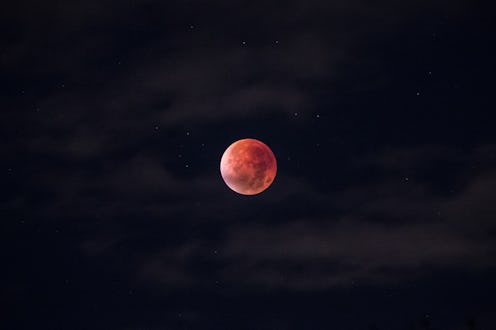Life
Why This Weekend’s Full Moon Is More Rare Than You May Have Realized

ICYMI, November is officially here, and it's bringing us some seriously frosty vibes. Maybe not weather-wise, though — I'm actually talking about the impending "frost moon" which is due to grace our skies this Nov. 4. The frost moon is a nickname of course, likely brought to us by the Native American's ancestors who named it so due to the change in cooler weather patterns a.k.a snow and frost left on the ground. While most of the US has not seen any frost yet, it still begs the question — frost or no frost — what makes this Frost Moon so special? Well, luckily, the answer isn't that difficult to find: the frost moon may not bring frost, but it will be a near-supermoon.
Just a quick supermoon refresher for those that need it: according to the website EarthSky.com, "a supermoon is a new or full moon closely coinciding with perigee — the moon’s closest point to Earth in its monthly orbit." Normal full moons, on the other hand, occur when the moon is on the side of the earth opposite to the sun when the three celestial bodies all line up. So, when the moon is full — and is also at perigee — that's when a supermoon happens. Visually, a supermoon can make the moon look at least 14 percent bigger and 30 percent brighter than it normally does according to Space.com While the most recent supermoon already happened on Jun. 24 this year, you can set your calendars for the next one, which is scheduled to occur on Dec. 3 — the Nov. full moon is only a near supermoon because we're not quite at perigree level. According to EarthSky.com, in 2017 we've actually experienced not one but four supermoons already this year, however three of them were not visible in the sky. Bummer.
So sorry folks, while the Frost Moon isn't a supermoon event, it doesn't mean there aren't some super fun facts and things to know about it — starting with the fact that this endearing nickname has been passed down over the generations and has deeply rooted ties to the Native Americans and colonial settlers. It also has a bevy of other interesting names: According to the website Universe Today, November's Frost Moon is also known as a “Blood” Moon, a "Beaver Moon," as well as "Hunters Moon" — the latter of which is a term that was coined by Native Americans and traditionally refers to a full moon that appears during the month of October. This year, things were slightly different, so the Hunters Moon didn't occur during October — instead, October's full moon was the Harvest Moon, which usually occurs in November when it's closest to the autumnal equinox. Once in a while, though, an October full moon falls closer, and things are a little switched around. So, in a way, the Frost Moon is a bit rare too!
According to Universe Today, the Hunters Moon was named so by Native Americans, who would use this moon to hunt and stalk up on prey for the long winter months ahead. "Traditionally, Native American hunters used the full moon of October to stalk deer and to spot foxes at night as they prepared for the coming winter. Because the fields were traditionally reaped in late September or early October, hunters could easily see foxes and other animals that came out to glean from the fallen grains," Universe Today reported.
Also according to Universe Today, "the first recorded mentions of a 'Hunter’s Moon' began in the early 18th century. The entry in the Oxford English Dictionary for 'Hunter’s Moon' cites a 1710 edition of The British Apollo, where the term is attributed to 'the country people.'"
So, supermoon or no supermoon, the Beaver/Frost/Blood/Hunters Moon will be out shining her big beautiful light this Nov. 4 — and I think it's clear that it's worth marking your calendar for.